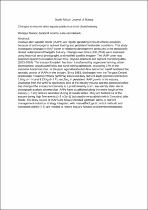JavaScript is disabled for your browser. Some features of this site may not work without it.
- ResearchSpace
- →
- Research Publications/Outputs
- →
- Journal Articles
- →
- View Item
| dc.contributor.author |
Nunes, M

|
|
| dc.contributor.author |
Adams, JB

|
|
| dc.contributor.author |
Van Niekerk, Lara

|
|
| dc.date.accessioned | 2020-10-08T09:24:28Z | |
| dc.date.available | 2020-10-08T09:24:28Z | |
| dc.date.issued | 2020-09 | |
| dc.identifier.citation | Nunes, M., Adams, J.B. and Van Niekerk, L. 2020. Changes in invasive alien aquatic plants in a small closed estuary. South African Journal of Botany, v135, pp 317-329. | en_US |
| dc.identifier.issn | 0254-6299 | |
| dc.identifier.issn | 1727-9321 | |
| dc.identifier.uri | https://doi.org/10.1016/j.sajb.2020.09.016 | |
| dc.identifier.uri | https://www.sciencedirect.com/science/article/pii/S0254629920310723 | |
| dc.identifier.uri | http://hdl.handle.net/10204/11620 | |
| dc.description | Copyright: SAAB. This is the abstract version of the work. For access to the fulltext, kindly visit the publisher's website. | en_US |
| dc.description.abstract | Invasive alien aquatic plants (IAAPs) are rapidly spreading in South African estuaries because of anthropogenic nutrient loading and persistent freshwater conditions. This study investigated changes in IAAP cover in relation to development pressures in the temporarily closed, subtropical uThongathi Estuary. Changes over time (1937-2018) were assessed using historical aerial photographs and rectified satellite imagery. The IAAP cover was assessed quarterly in relation to river flow, physico-chemical and nutrient monitoring data (2015-2018). The estuary floodplain has been transformed by sugarcane farming, urban development, uncultivated fields and sand mining operations, occupying 27% of the estuarine functional zone. In the past, agricultural return flow and urban runoff facilitated the sporadic growth of IAAPs in the estuary. Since 1983, discharges from the Tongaat Central Wastewater Treatment Works (WWTW) increased daily nutrient loads (current contribution: 1.8 kg d−1 N and 9.63 kg d−1 P), resulting in persistent IAAP growth in the estuary. Discharge from the WWTW represents 15% of the estuary volume and the increased inflow has changed the estuary functionality to a predominantly open, low salinity state. Aerial photograph analysis showed that IAAPs have established along the entire length of the estuary (∼7 km) and are abundant during all mouth states. They are flushed out of the estuary during high flow events (≥ 5 m3s−1) but steadily re-establish (within 3 months) after floods. The likely source of IAAPs are heavily infested upstream dams. A nutrient management reduction strategy integrated with manual/biological control methods and increased salinity (> 5) are needed to restore estuary function and prevent infestations. | en_US |
| dc.language.iso | en | en_US |
| dc.publisher | Elsevier | en_US |
| dc.relation.ispartofseries | Worklist;23817 | |
| dc.subject | Catchment land-use change | en_US |
| dc.subject | Flow modification | en_US |
| dc.subject | Wastewater treatment works | en_US |
| dc.subject | Eutrophication | en_US |
| dc.subject | Estuarine functionality | en_US |
| dc.title | Changes in invasive alien aquatic plants in a small closed estuary | en_US |
| dc.type | Article | en_US |
| dc.identifier.apacitation | Nunes, M., Adams, J., & Van Niekerk, L. (2020). Changes in invasive alien aquatic plants in a small closed estuary. http://hdl.handle.net/10204/11620 | en_ZA |
| dc.identifier.chicagocitation | Nunes, M, JB Adams, and Lara Van Niekerk "Changes in invasive alien aquatic plants in a small closed estuary." (2020) http://hdl.handle.net/10204/11620 | en_ZA |
| dc.identifier.vancouvercitation | Nunes M, Adams J, Van Niekerk L. Changes in invasive alien aquatic plants in a small closed estuary. 2020; http://hdl.handle.net/10204/11620. | en_ZA |
| dc.identifier.ris | TY - Article AU - Nunes, M AU - Adams, JB AU - Van Niekerk, Lara AB - Invasive alien aquatic plants (IAAPs) are rapidly spreading in South African estuaries because of anthropogenic nutrient loading and persistent freshwater conditions. This study investigated changes in IAAP cover in relation to development pressures in the temporarily closed, subtropical uThongathi Estuary. Changes over time (1937-2018) were assessed using historical aerial photographs and rectified satellite imagery. The IAAP cover was assessed quarterly in relation to river flow, physico-chemical and nutrient monitoring data (2015-2018). The estuary floodplain has been transformed by sugarcane farming, urban development, uncultivated fields and sand mining operations, occupying 27% of the estuarine functional zone. In the past, agricultural return flow and urban runoff facilitated the sporadic growth of IAAPs in the estuary. Since 1983, discharges from the Tongaat Central Wastewater Treatment Works (WWTW) increased daily nutrient loads (current contribution: 1.8 kg d−1 N and 9.63 kg d−1 P), resulting in persistent IAAP growth in the estuary. Discharge from the WWTW represents 15% of the estuary volume and the increased inflow has changed the estuary functionality to a predominantly open, low salinity state. Aerial photograph analysis showed that IAAPs have established along the entire length of the estuary (∼7 km) and are abundant during all mouth states. They are flushed out of the estuary during high flow events (≥ 5 m3s−1) but steadily re-establish (within 3 months) after floods. The likely source of IAAPs are heavily infested upstream dams. A nutrient management reduction strategy integrated with manual/biological control methods and increased salinity (> 5) are needed to restore estuary function and prevent infestations. DA - 2020-09 DB - ResearchSpace DP - CSIR KW - Catchment land-use change KW - Flow modification KW - Wastewater treatment works KW - Eutrophication KW - Estuarine functionality LK - https://researchspace.csir.co.za PY - 2020 SM - 0254-6299 SM - 1727-9321 T1 - Changes in invasive alien aquatic plants in a small closed estuary TI - Changes in invasive alien aquatic plants in a small closed estuary UR - http://hdl.handle.net/10204/11620 ER - | en_ZA |






